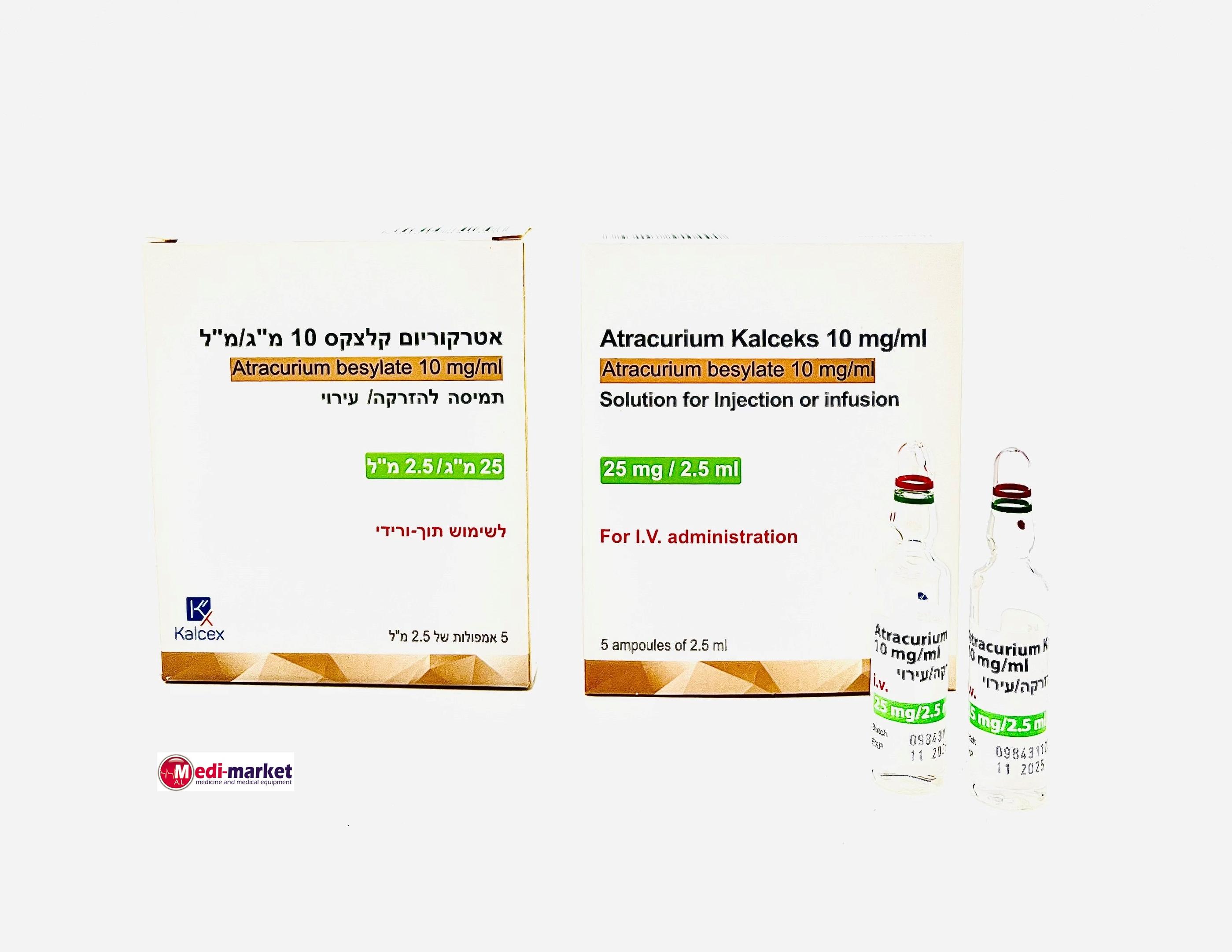Quest for the right Drug

אטרקוריום קלצקס 10 מ"ג/מ"ל ATRACURIUM KALCEKS 10 MG/ML (ATRACURIUM BESYLATE)
תרופה במרשם
תרופה בסל
נרקוטיקה
ציטוטוקסיקה
צורת מתן:
תוך-ורידי : I.V
צורת מינון:
תמיסה להזרקהאינפוזיה : SOLUTION FOR INJECTION / INFUSION
עלון לרופא
מינוניםPosology התוויות
Indications תופעות לוואי
Adverse reactions התוויות נגד
Contraindications אינטראקציות
Interactions מינון יתר
Overdose הריון/הנקה
Pregnancy & Lactation אוכלוסיות מיוחדות
Special populations תכונות פרמקולוגיות
Pharmacological properties מידע רוקחי
Pharmaceutical particulars אזהרת שימוש
Special Warning עלון לרופא
Physicians Leaflet
Adverse reactions : תופעות לוואי
4.8 Undesirable effects The most commonly reported adverse reactions during treatment are hypotension (mild, transient) and skin flushing, these events are attributed to histamine release. Very rarely, severe anaphylactoid or anaphylactic reactions have been reported in patients receiving atracurium in conjunction with one or more anaesthetic agents. Adverse reactions are listed below by system organ class and frequency. Frequencies are defined as: very common ( > 1/10), common ( >1/100 to < 1/10), uncommon ( >1/1000 to < 1/100), rare (>1/10 000 to < 1/1000), very rare (< 1/10 000). Very common, common and uncommon frequencies were determined from clinical trial data. Rare and very rare frequencies were generally derived from spontaneous data. The frequency classification "Not known" has been applied to those reactions where a frequency could not be estimated from the available data. Clinical Trial Data Vascular Disorders Common Hypotension (mild, transient)#, Skin flushing# Respiratory, thoracic and mediastinal disorders Uncommon Bronchospasm# Post-Marketing Data Immune system disorders Very rare Anaphylactic reaction, anaphylactoid reaction including anaphylactic shock, circulatory failure and cardiac arrest Very rarely, severe anaphylactoid or anaphylactic reactions have been reported in patients receiving atracurium in conjunction with one or more anaesthetic agents. Nervous system disorder Not known Seizures There have been reports of seizures in ICU patients who have been receiving atracurium concurrently with several other agents. These patients usually had one or more medical conditions predisposing to seizures (e.g. cranial trauma, cerebral oedema, viral encephalitis, hypoxic encephalopathy, uraemia). A causal relationship to laudanosine has not been established. In clinical trials, there appears to be no correlation between plasma laudanosine concentration and the occurrence of seizures. Skin and subcutaneous tissue disorders Rare Urticaria Musculoskeletal and connective tissue disorders Not known Myopathy, muscle weakness There have been some reports of muscle weakness and/or myopathy following prolonged use of muscle relaxants in severely ill patients in the ICU. Most patients were receiving concomitant corticosteroids. These events have been seen infrequently in association with atracurium and a causal relationship has not been established. Events which have been attributed to histamine release are indicated by a hash (#) Description of selected adverse reactions Anaphylactic reaction, anaphylactoid reaction including anaphylactic shock: Very rarely, severe anaphylactoid or anaphylactic reactions including anaphylactic shock have been reported in patients receiving atracurium in conjunction with one or more anaesthetic agents. Reporting of suspected adverse reactions Reporting suspected adverse reactions after authorisation of the medicinal product is important. It allows continued monitoring of the benefit/risk balance of the medicinal product. Any suspected adverse events should be reported to the Ministry of Health according to the National Regulation by using an online form: /https://sideeffects.health.gov.il

שימוש לפי פנקס קופ''ח כללית 1994
לא צוין
תאריך הכללה מקורי בסל
01/01/1995
הגבלות
תרופה מוגבלת לשימוש בבתי חולים או אשפוז יום
מידע נוסף
